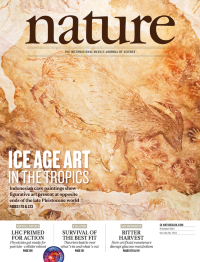Volume 514
-
No. 7524 30 October 2014
The Science Citation Index has been with us for 50 years. Launched as a print publication in May 1964 by Eugene Garfield, founder of the Institute of Scientific Information the SCI � most notably in its later electronic manifestations � revolutionized the scientific professions approach to data searches and became a model for the assessment of the importance of research papers. To mark this occasion Nature asked Thomson Reuters, which now owns the SCI, to list the 100 most highly cited papers of all time on the Web of Science. It proved an interesting exercise, and one not without its surprises.
Nature Outlook
-
No. 7523 23 October 2014
A magnetic model of the Sun before a solar eruption produced by an ejected magnetic rope (top/blue) using data from the Helioseismic and Magnetic Imager of the NASA Solar Dynamics Observatory mission. Coronal mass ejections are large-scale eruptions in the solar atmosphere that consist of a giant cloud of solar plasma embedded in a magnetic field. They have the potential to produce solar storms here on Earth that can damage artificial satellites and disrupt ground-based power generation. Using observations of the photospheric magnetic field made during the four days leading up to the coronal mass ejection of 13 December 2006, together with numerical modelling, Tahar Amari et al. show that the physical mechanism responsible for such ejections is best explained as the appearance and the later ejection of a twisted rope� of magnetic flux. Cover: Tahar Amari/ CNRS-Ecole Polytechnique. France.
-
No. 7522 16 October 2014
Universities must evolve if they are to survive. This special issue of Nature on the theme The university experiment� examines the myriad ways in which universities around the world are trying to free themselves from old habits of thought, and to explore new ways of doing things. No one knows which of these experiments will produce the best-educated students or the greatest leaps in academic understanding (see leading article on page 273). But all share the sentiment that the twenty-first-century university could be strikingly different from the institutions of the past.
Nature Outlook
-
No. 7521 9 October 2014
A representation of an anoa � a type of dwarf buffalo � and human hand stencils from a cave in Sulawesi, Indonesia. New dating results challenge the traditional view that western Europe was the centre of a crucial stage in the evolution of modern human intelligence and culture � based largely on the emergence of figurative or representational art in cave paintings and sculptures around 40,000 years ago. New dating data on a series of hand stencils and paintings of wild animals from caves in the Maros karst in Sulawesi, Indonesia, suggest that figurative art appeared at more or less the same time at opposite ends of the Late Pleistocene world. Or was cave painting practised by the first Homo sapiens to leave Africa tens of thousands of years earlier? Cover: Maxime Aubert.
-
No. 7520 2 October 2014
The Procellarum is a broad feature on the nearside of the Moon, characterized by low elevations and thin crust, and largely covered by dark basalts that can be seen from Earth with the unaided eye. The red colours on the cover image show gravity anomalies bordering the Procellarum region, calculated with data from the Gravity Recovery and Interior Laboratory (GRAIL) mission. The background globe represents the topography of the Moon as measured by the Lunar Orbiter Laser Altimeter (LOLA). Andrews-Hanna et al. interpret the observed gravity anomalies as evidence of ancient lava-flooded rift zones buried beneath the volcanic plains (or maria) on the nearside of the Moon. Cover: NASA/ Colorado School of Mines/ Goddard Space Flight Center/ Scientific Visualization Studio





